Satellite TV
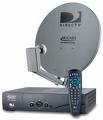 |
|
 |
Many RVers partake of the convenience of satellite TV, and not having to be at the mercy of no TV, poor over-the-air TV reception, or RV park cable TV (often at an extra charge).
Satellite TV is available just about anywhere in the United States, as long as your TV is not parked under dense trees that block the southeastern sky. Receiving satellite TV in your RV is possible from just about any place in the USA, and also in most of Mexico, the Canadian provinces, and the southern portion of Alaska. However, in the northern parts of Alaska, the TV satellite is just about at the horizon (or below the horizon)—making reception very questionable or impossible. In some parts of Alaska, reception is still possible if a larger dish is used (capturing more of the distant satellite signal).
The lure for most RVers is being able to get TV reception just about anywhere, except the loss of their "local channels" when they are more than about 200 miles from home.
Full-Time RVers and Extended-Time RVers usually go to the troouble of getting a "waiver" so that they can receive both East (New York City) and West (Los Angeles) feeds of the three major networks (ABC, CBS, and NBC), and also Fox.
Satellite TV, for your home or your RV, comes primarily from DirecTV or Dish Network in the United States, and from Express Vue in Canada.
For RVers, there are four choices of antenna to use for receiving satellite TV:
- Portable dish—on a tripod, pole or whatever
- Manual roof-mounted dish—adjustable from inside the RV
- Roof-mounted dome dish—antenna inside a dome; either manual or automatic
- Piggy-back antenna on satellite Internet antenna
Portable Satellite Dish
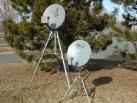
A portable satellite dish is the most common means of RVers getting satellite TV reception. It is the least expensive option, and it has the advantage of the RVer not being concerned about parking under nice shade trees.
The two biggest problems with portable satellite dishes are properly aiming the dish to get satellite reception, and the propensity of the dish to be blown over in even sometimes small wind gusts. But just drive through almost any RV park and you will see resourceful solutions to the wind problem, as well as many different types of dish antenna support poles, masts, and other contraptions.
Some enterprising RVers have even built a dish mount where the dish is mounted upside down; and, yes, folks, they work well and significantly lower the wind resistance of the erected dish.
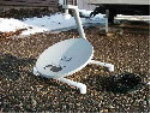
For those of you about to go buy some coax for your new portable satellite antenna, please be aware that there are two main types of coax (and only one will work correctly). Be sure that you purchase RG-6 coax and not RG-59 coax. The RG-6 coax looks thicker and will cost you a bit more, but the RG-59 coax has far too much signal loss at the satellite frequencies to be of any use.
Setting up a portable satellite dish isn't the easiest tasks in the world, but experienced RVers can often accomplish the task in five or ten minutes—especially if they have DirecTV service.
You can accomplish the task with only a compass and a small torpedo level, but also having a Satellite Finder meter makes the task much easier.
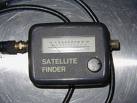
The setup procedure for aiming your portable satellite dish is fairly straightforward:
- Enter Zip Code in DSS receiver and find the correct azimuth and elevation for your present location.
- Set your dish to the proper elevation (usually somewhere between 30 and 50 degrees).
- Using your compass, find a clear spot toward the satellite (usually somewhere in the neighborhood of 130 to 150 degress—at least for DirecTV). Avoid any close-by trees that might block satellite reception.
- Set up your tripod (or other dish support) and be sure that the pipe is vertical in both directions. Use your level to set the pipe in one direction, and then move the level 90 degrees around the pipe and check again for level. (Plumb is the correct term for you techies out there.)
- Now aim your dish in the general direction that the compass indicates is correct for your location.
- Now for the difficult and sometimes frustrating step—trying to find the satellite. If you have a good navigator and FSR radios, you can commence the frustrating task of slowly moving the dish back and forth, listening to your navigator say, "No, no, no, yes, too far, back up, no, no, yes, stop!" Of course, trying to maximize the received signal this way is just about impossible.
- Using an inexpensive Satellite Finder meter makes the task of finding the
satellite much more easy, and can be accomplished by only one person.
You need to have a short piece (about three feet) of RG-6 coax attached to your LNB (the "white bulb thingy" that is aimed at the center of your satellite dish).
Connect the Sat Finder meter to the short coax—being sure to watch the markings on the back of the meter (usually saying LNB and receiver).
Attach the short coax to the LNB connector on the meter, and connect the cable to your DSS receiver to the other connector on the meter.
Be sure your DSS receiver is turned on (a light inside the Sat Finder meter should illuminate the meter face).
Turn the Sensitivity knob on the meter until the needle is in the middle of the scale (about half way from left to right).
Slowly turn the dish to one side (turn, stop, turn, stop) and watch for the needle to go up (toward the right). If the needle gets near the right edge, turn down the sensitivity until the needle is again near the center of the scale. Continue turning the dish until the signal strength gets to its maximum and then starts to fall back. (If you did not find the satellite, go back to your starting point and begin turning the dish in the other direction.
Once you find the satellite signal, make very small position adjustments to get the maximum signal strength.
Finally, grab the top of the dish and gently push it a wee bit forward and a wee bit backward to see if you need to slightly adjust the elevation. Your goal is to maximize the received satellite signal.
I know this procedure may seem a bit complicated, but once you have done it a few times (and been helped by a friendly RVer or two), you will get the hang of it. When you are back in your rig enjoying satellite TV (or its music), you will have a smile of satisfaction on your face.
Manual Roof-Mounted Dish
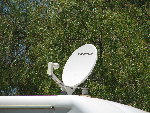
The manual roof-mounted dish is much simpler and faster for finding the correct satellite. You don't have to even know the azimuth! Simply crank up the roof dish until it is at the proper elevation. (Most roof-mounted dishes come with a digital readout telling you the elevation of the dish as you crank it up.)
Since most roof-mounted satellite TV dishes are mounted near the front of the RV (and so is the main TV), it is a simple matter to turn the dish and watch or listen for the TV to tell you when you have found the proper satellite and have maximized the signal strength.
With the satellite receiver set to show "signal strength" on your TV screen, slowly turn the roof dish until the signal shows up—then gently "tweak" both the azimuth and elevation for greatest signal strength.
TIP:

If you have DirecTV, position your dish to the East, and then
slowly turn it toward South—until you find the satellite.
If you have Dish Network, position your dish to the South, and
then slowly turn it toward East—until you find the satellite.
Many Dish Network customers get very irritated at the hassle of trying to
adjust their antenna to get both the 110 and 119 satellites at the same time. Instead of
trying to "split the needle," try this: Tell your receiver that you only
have a Dish 300 dish (even if you have a 500). Select satellite 119, and
you will then get antenna pointing angles that are more accurate. Sure, you
only get satellite 119, but that is where the bulk of the Dish Network
programming resides.
Compared to setting up, leveling, and adjusting a portable satellite dish— before you even begin trying to find the satellite— using a manual roof-mounted dish is a "piece of cake."
Roof-Mounted Dish (Inside a Dome)
Roof dishes inside a dome are easier to use and are shielded from the extremes of weather. All satellite TV systems, however, can be affected by heavy rain or snow— often interrupting satellite TV reception until the rain or snow has abated somewhat.
There are, generally, two types of dishes within a dome—semi-automatic dishes and fully automatic dishes.
With a semi-automatic dish, you park your RV, get it level, and then turn on your satellite TV and dish hardware. Then, the electronics in the dome will find the correct satellite for you. Dish Network users will have to tell the system whether to find the 119 satellite or the 110 satellite (not both at the same time). Some of the newer systems provide you with a remote that lets you easily switch back and forth between 119 and 110.
With an automatic dish, the electronics in the dome causes the dish to the aligned with the proper satellite even while you are driving down the road.
Piggyback Antenna on Internet Antenna
For those individuals fortunate enough to have an on-the-roof satellite internet setup, it is a simple matter to attach a piggyback DirecTV LNB to the dish arm. This setup easily allows the LNB to be aimed at the DirecTV satellite (almost in the same geo-stationary orbit as the Direcway satellite used for Internet access). When the Internet dish is aimed correctly for Internet access, the DirecTV LNB is correctly aimed to receive satellite television signals.
For those individuals who use a portable dish setup for Internet access, the same piggyback
LNB arrangement can be used to receive DirecTV satellite signals.
RV Waiver
Most of the full-timers have taken the time (and, sometimes, incurred a long hassle) in order to get an RV Waiver from either DirecTV or Dish Network.
With an RV Waiver, you are able to obtain the "now-lost-to-the-average-guy" ability of being able to receive East and West coast network feeds from the major network stations in New York and Los Angeles. This is a major advantage when you are out in the hinterlands and outside the approximate 200-mile zone of the satellite spot beam that broadcasts your local channels. Many folks have discovered, to their dismay, that they lose their local channels if they venture more than about 200 mies from home.
By having both East and West coast feeds, you can receive the national news and most of your favorite TV shows. Another advantage (for the one-feed TIVO users) is that you can split your recording chores between the East and West coast, often recording your shows three-hours earlier (if you are on the West coast).
Unfortunately, RV folks in some areas are having a difficult time getting an RV Waiver, because their local TV stations are afraid of losing advertising revenue. (What a lame excuse.)
For those of you who are enjoying the benefits of TIVO, smile and enjoy your TV watching. We certainly do.
Do You TIVO?
Many folks have become accustomed to the convenience of being able to record TV programs for future viewing. Not being glued to your TV to see all your favorite shows can be a very liberating experience.
Many folks are rather disappointed, however, when they try to take their TIVO unit on the road in their RV. Most TIVO units allow a person to watch one program while they are recording another program on the TIVO. The wrinkle is that this convenience requires that the TIVO unit have two inputs from the satellite dish, but most roof-mounted RV satellite antennas have only a single feed from the dish.
Many folks have adapted to this limitation, and are still glad to be able to record their favorite TV programs while they are exploring the nearby locale.
For those folks who have one of the original TIVO units (and not the later DirecTV knockoff), there is little trouble in setting up your TIVO on the road, since you are able to tell the system that you only have a single feed.
If you have one of the later model TIVO knockoffs from DirecTV, setting up your TIVO on the road can be a real pain in the posterior, since the DirecTV folks have to do something on their end—to eliminate the annoying message that the receiver can't find the second satellite feed. This message refuses to go away, and visually interferes (in a big way) with you being able to comfortably watch TV.
Folks using a portable satellite dish won't have this problem, since they can easily run a second coax from the LNB to their receiver (but, unfortunately, not using the built-in wiring of their coach).
I have not taken the time,yet, to crawl up on the roof of my motorhome to check out the LNB of my Winegard satellite dish to see if it really might have a dual LNB (but I seriously doubt it). I also want to take a look at how the coax cable is run into the motorhome—with the ulterior motive of swapping out the Winegard LNB for a DirecTV dual-output LNB, so that we can enjoy the full utility of our real TIVO.
When we ordered a second TIVO, we were very disappointed to find out that DirecTV sent us their new TIVO knockoff—where the user interface is not nearly as nice (as well as the RV setup problem that was just mentioned).
On a whim, we jumped on eBay and looked for the older TIVO R10 receiver. Much to our surprise, we found that there were many of these units for sale—and the price, if you were careful, could be less than $80. Yes, we were smiling ear-to-ear. We immediately had the used TIVO (with the old DirecTV access card) fired up and had DirecTV change the access card to our account. And, we have been enjoying our TIVO in the motorhome just like we do at home (except for not being able to watch one program while we record another).
Many folks say that, if you buy a used receiver, you will be required to shell out $20 for a brand new access card, but we didn't find that to be the case. Maybe it just depends on which service tech you happen to get connected with on the other end of the line.
Gotta Have It All?
Surprise! After two years of yearning, Linda really wanted a full-function TIVO setup, so we set out to modify our manual rooftop satellite dish—to add a second feed from the dish, including a new dual-feed LNB.
The factory-installed Winegard satellite dish had a single feed into the motorhome from the dish, but the TIVO box requires two feeds to get full functionality—being able to simultaneously record two different TV programs or to record one program while simultaneously listening to satellite music.
We expected to change out what we thought was a single-feed LNB on the Winegard dish, but we happily discovered that the Winegard LNB was already a dual-feed model, even though only one feed was used.
The challenge was getting the second RG-6 coax installed—easily attached to the LNB, but not so easily routed down through the roof of the motorhome, and then over to the driver's side overhead compartment housing the TIVO box.
Routing the new coax above the ceiling and below the roof seemed a daunting challenge, especially since it was not an easy job to remove the front TV or the wooden bezel surrounding it.
On a hunch (read that as "getting desperate"), we removed the center overhead surround sound speaker that was mounted just in front of the elevation and azimuth mechanism (the crank in the ceiling) for the satellite dish.
Whew! All of a sudden we had visual and spacial access to where the coax cables came down through the roof, as well as a small channel where the coax cables came out above the overhead TV.
Using a fish wire, it was not that difficult to get from the speaker hole in the ceiling to a space above the TIVO compartment. Whew, the hard part was done.
The most important task, however, was re-installing the roof-top cover plate over the two coax cables, and then using almost an entire tube of specialized RV caulk to be sure that the RV roof was once again weather- tight.
Yes, the dual-feed from the satellite dish now allows our TIVO to fully function as intended—and Linda is once again a very happy camper!
